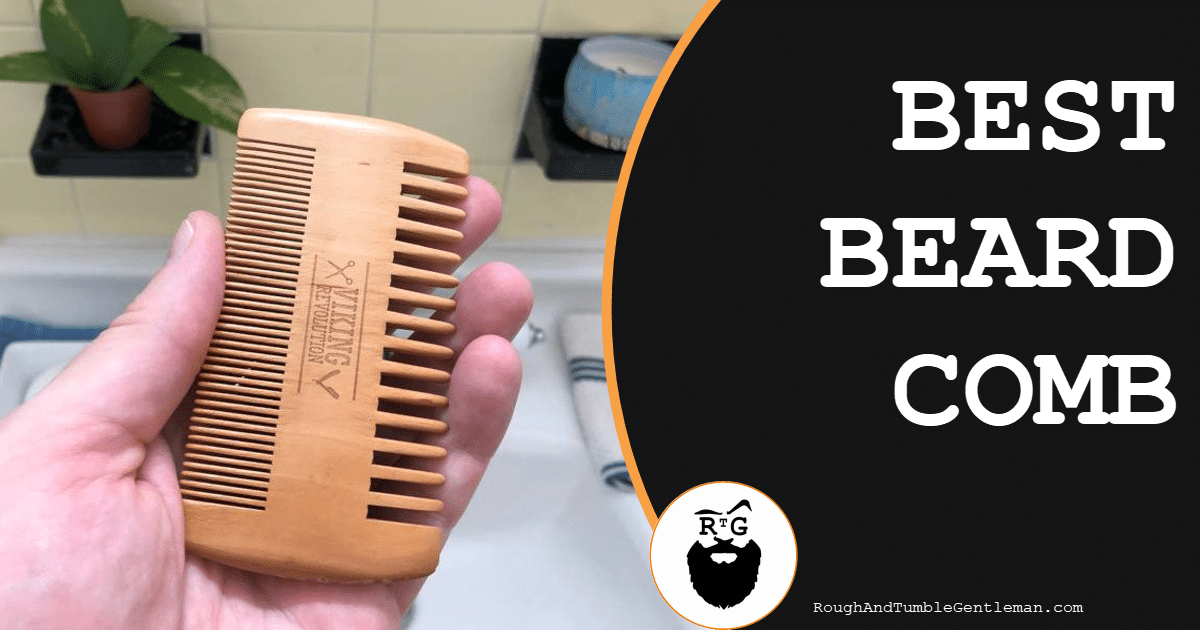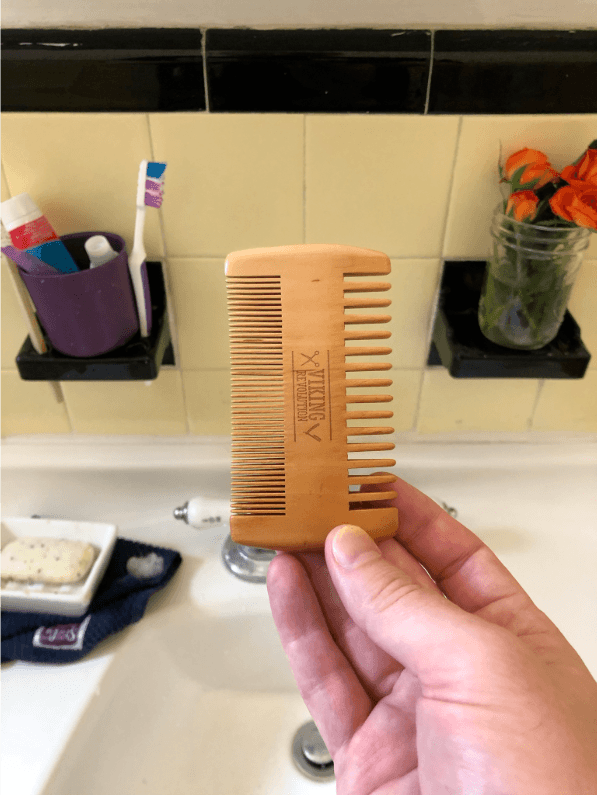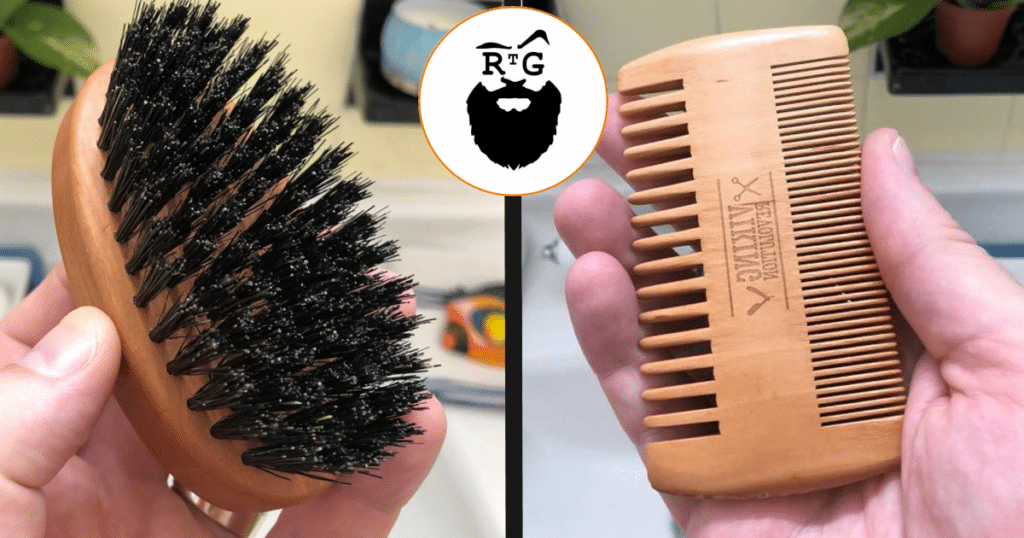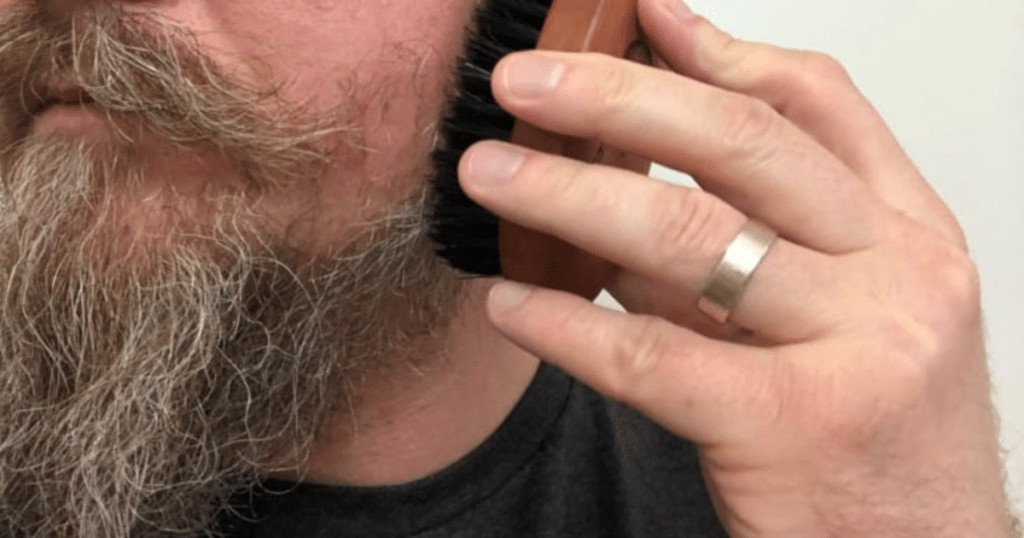Beard combs! They’re the “settle down, son” of beard tools, and they help untangled knots, provide some shape and form to your facial hair, and help distribute grooming products (like balm and wax) evenly throughout your whiskers. They’re a fantastic tool, and the well-made ones can be little works of art.
In this post, we’ll provide a few quick tips on how to select a beard comb, discuss the models we think belong in the “best beard comb” category, and give you a couple of tips on how to effectively comb a beard. We’ll start with…

Tips for Finding A Great Beard Comb
You’d think that growing and grooming a beard would be simple, but noooooo! Nothing is simple. And, of course, beard combs are no different.
But… isn’t that part of the fun of it?
There are a couple of different features that make beard combs unique, and they are:
Materials: Wood, Ox Horn, and, Of Course, Plastic
We’ll start with wooden combs. Wooden combs are popular not only due to their looks but also their performance. The highest quality beard wooden combs are handcrafted, often using a saw blade, and this allows precise cuts along the teeth, giving you an even edge. Teeth sides are polished down for a smoother glide across hair, while ends should be polished to a rounded tip that doesn’t damage skin. They groom hair without causing snagging, and the porous nature of wooden combs is great for collecting and spreading oil throughout your beard. A very popular—and our personal favorite—type of wood use in many different combs is sandalwood. It’s got a crisp, clean scent, and it’s relatively dense, which means that teeth give your skin a gentle massage with each stroke of the brush.
Ox horn is another popular material for beard combs (and for combs of all types, actually), and it’s got a very unique, and very fascinating, property that makes it great for combs: on a molecular scale, horn is relatively similar to hair, and that makes an ox horn comb a great option for beard grooming, because it doesn’t produce friction against coarse strands. An ox horn comb can provide smooth, even strokes that won’t cause any damage to your whiskers—and that’s a fantastic feature, especially if you’ve got a thick, lush beard. It can also be gentle on sensitive skin, and that’s another plus. Ox horn combs are sold in a variety of colors, from creamy yellow to deep black, and some guys consider these the best beard comb because they’re somewhat rare, but really it’s a matter of personal taste.
Last up: plastic. Some plastic combs are good, some are bad. Many are poured into a mold and stamped out, which can lead to imperfections in the teeth, while others are made from a synthetic polymer that can react to sensitive skin and cause itching and rashes. Others might actually generate a static charge, which can be quick unpleasant to experience—and it’s one of the big advantages of a wooden or ox horn comb.
That said, there is one type of plastic that works well on a comb, and that’s cellulose acetate plastic. It’s a high-quality material that doesn’t cause the same harmful effects as more commonly found plastics, and it can be gentle and smooth and polished down to prevent jagged edges. This type of material can’t trap oils like wood or ox horn, but it’s still a good choice for shaping and styling.
There’s one other material that combs are sometimes made from, and that’s metal. Metal combs may seem like a good, durable option for thick beards, but metal is generally a poor choice when it comes to grooming products. Most machined metals have small jagged edges, much like certain plastics, and cause damage to the hair. Metal is also hard on the skin and may lead to irritation.
Teeth: Spacing and Type
The individual teeth of a comb are called “tines,” and the tines on a good beard comb should be smooth and polished around their entire surface. Nooks and crannies in tines can lead to tangles and split ends, which not only places stress on follicles but also means that you need to trim your beard more frequently.
Comb teeth come in all shapes, sizes, and lengths to cater to different beard styles. Do you have a thick, natural beard? Then a wide-toothed comb is probably your best option, as finer teeth can get caught in dense hair and tug against follicles.
For short, sparse, or new beards, it’s usually better to opt for a fine-toothed comb. Narrow spacing better smooths out each hair for a sleek overall appearance, and in general, the finer the teeth, the straighter the beard.
Medium teeth give you a little bit more versatility with your comb and make an excellent choice for just about any beard. They’re able to tame and tease hairs into submission without making your beard appear overly straight or stylized.
We’re a big fan of combination combs, which offer two different tooth styles on either side of the piece. This gives you multiple grooming options depending on the state of your beard, and you can use a combination comb for all stages of growth, from new fuzz to a fully-fledged beast.
No matter what a comb’s teeth look like, they should have a solid construction that’s well attached to the body. Teeth made of flimsy plastics and other weak materials are prone to breaking off, making every stroke less effective.
Portability and Ease of Travel
Beard combs come in all sorts of ergonomic shapes and sizes depending on their use. You can find pocket beard combs for easy storage, folding and switchblade style combs for travel, and even wallet beard combs as a handy backup. Larger combs and combs that are more delicate are great for your home bathroom, but if you’re going to be traveling, it may make more sense to get something you can stash in a suitcase or backpack or travel bag.
Best Beard Comb Reviews: A Closer Look
You’d be surprised to learn that there are a lot of beard combs out there. Some are fantastic, some are meh, and some are basically trinkets that are going to get stuck in your whiskers and torture you.
Here are the ones we like, divided by category:
The Kent Handmade Beard and Mustache Comb
Best Old-School, No-Frills Beard Comb
The Kent Handmade Beard and Mustache Comb a classic, old-school style comb, and if you read a lot of web sites related to shaving (and oh my goodness, we do), this will most likely be on a lot of “Best Beard Comb” lists. It’s simple, it’s sleek, and it’s handsome. It’s manufactured in two-tone brown—a blondish-brown layered into a darker mahogany-color—and has that old-school, barbershop feel.
And, even though this is plastic—admittedly, the lower-tier of beard comb materials—it’s made from cellulose acetate, which, as we mentioned is the type of plastic you’d hope to see if you’re buying a plastic product (plastic isn’t all bad, by the way—it’s durable, long lasting, doesn’t chip like wood, and isn’t as delicate as ox horn).
As for the dimensions of the comb and the teeth, the one we’re reviewing is a smaller model with tighter tines, but Kent manufacturers the products in a range of sizes and models. If you look around, there are occasionally Kent “packages,” and we like the Kent Set of Three.
There are a lot of fascinating companies and products in the world of shaving, and in our humble opinion this is one of them—Kent, as a company, was founded in 1777 in London (and is still in England today), and this comb has an old-world, “storied” feel. A good pick, in our humble opinion.
Beardilizer Ox Horn and Sandalwood Comb
Our Pick for Best Ox Horn Model
Speaking of old school, “horn” is pretty darn old-school, and because ox is a domesticated livestock, it’s been used for personal items like combs, brushes, soap dishes, jewelry holders, cups, and so on for many millennia.
We think the Beardilizer Beard Comb is a great pick: it’s made from two materials—sandalwood and ox horn—and it’s got a gently-curved spine that’s an interesting alternative to the straight-spined combs you often see. And as we mentioned earlier, ox horn is one of those materials that inhibits static build-up, and that’s a great property for any type of grooming instrument you’ll be running through body hair.
Because oxen are domesticated for reasons other than their horns (namely, plowing, transport, and threshing), ox horn beard combs—and any ox horn comb, for that matter—is somewhat rare, so we think this is something of a find.
Rocky Mountain Barber Company Sandalwood Comb
Best Sandalwood Pick
Sandalwood is used a lot in shaving products, and for good reason: as a wood, it’s tactile and strong and has a pleasing appearance (so it’s used for a lot of shaving equipment, like razor handles and bowls and comb spines); as an essential oil, it has deep-yet-sweet smell (so it’s a great choice for shaving creams, beard oils, and various balms). It’s got a lot of properties that are fantastic for grooming.
With that in mind, we like the Rocky Mountain Barber Company Sandalwood Comb. First things first, “Rocky Mountain Barber Company” is a great name for a company that makes shaving products. It doesn’t really matter—that’s just marketing—but we’re suckers for that kind of thing, and it’s a great tag. The real feature of this comb is the design, though, because it’s got everything we’d want in a comb: wide-spaced tines on the top of the comb (3mm wide), with thinly-spaced (1mm wide) tines below it; a gentle inward curve to both rows of teeth, so that the comb can curve around your chin and neck line; and it’s ever-so-slightly rounded: many smaller combs are somewhat flat, and this has a nice shape that fits the hand. Plus it comes with a protective case, so you can throw the comb in your backpack/briefcase/whatever and not worry about
We’re big fans of this comb (and a lot of other Rocky Mountain products), and it can make a great addition to your own shaving stash (you ‘stache stash), but it’s also got great gift potential for a father/son/friend who has or is growing a beard.
Striking Viking Folding Wooden Comb
A Great Folding Option
The Rocky Mountain Comb we just reviewed featured a carrying pouch, but some combs don’t require that sort of thing. The Striking Viking Folding Wooden Comb (another great name) is one example: it folds on a hinge so that the comb itself is protected by the wooden casing. It’s a clever design, and we find it to be one of those products that meets its purpose, but is also just fun to use: the comb slides smoothly and fits nicely into the casing, and that’s one of those “oddly satisfying” features we like a lot.
But it’s got a lot of other nice features, as well: it’s made of sandalwood (always a plus); it’s compact (which makes it great for tossing in a bag and traveling); and most importantly—and most uniquely—the tines on the wood taper down to a somewhat-sharpened point. That’s not the case on a lot of beard combs, and if you take a look, you’ll notice that the tines on most wooden combs are a uniform thickness from top to bottom. That’s okay, but a tine that tapers down to a curved point will have an easier time working its way through your whiskers, and—that’s the whole purpose of a comb. It’s a really fantastic feature of this comb that’s easy to overlook, and it adds a lot of value to it.
Some guys don’t like that folding aspect of the comb, and it might not be a perfect fit for your home set of shaving supplies—too much use can weaken the hinge—but if you want a carrying case and are the kind of guy who 1) wants a carrying case but will also 2) probably lose that carrying case, a carrying case that is attached to the comb can be a great thing.
The Striking Viking Grooming Kit
Best Combo Pack
One of our favorite aspects of shaving products is that they package so nicely together. Balms and oils, scissors and razors, bowls and creams—there are a lot of nice “combo” items that go great together.
That’s why we like the Striking Viking Brush and Comb Set. As we discuss below, beard brushes and beard combs are part of a one-two-punch routine—beard brush first, to untangle larger knots, and then beard comb second, to smooth things out—so it can be a boon to have both of those tools at the same time. And, as we’ve already sung the praises of Striking Viking, we think this is a good combo: rounded brush with boar bristles (which is usually only found on higher-end brushes), a two-sided comb with teeth at two different sets of spaces (non-folding, by the way), and a pouch for the comb. A great option, in our estimation.
Comb vs. Brush: Believe It or Not, They’re Different
So now that we’ve discussed the models we like, let’s go a little more in-depth.
You might imagine that combs and brushes are the same thing, and why wouldn’t they be? If you close your eyes and imagine the difference between a comb and a brush, you might come up blank. We did, anyway, before we grew beards.
Beard combs and beard brushes actually different, though, and they perform different functions. A beard brush looks like this:

It’s usually a broad tool that you hold in the palm of your hand, and the bristles on the brush are thick and tough and positioned very closely together.
A beard comb, on the hand, looks like this:

There are two beard combs in the image above: the brown plastic set next to the pair of scissors, and the wooden one at the top right-hand corner. As you can see, they’re flat, you can hold them between your fingers, and they have rows of teeth spaced apart at even distances. The brown plastic set next to the scissors even have two sets of teeth: one set spaced closely together, and one set spaced a little further apart.
So what’s the difference in usage?
A beard brush is usually the first thing you reach for when you’re taming your beard. Because an untamed beard will usually have knots and tangled whiskers, you’ll want to brush those out, and the toughness of a beard brush is the right tool for the job. You’ll have to use some effort—and it might hurt a little bit, because working the brush through those beard knots will tug at your whiskers and at your skin—but a good beard brush will provide some smoothness to your whiskers.
A beard comb is a little more delicate, and after you’ve gone through your beard with a brush, you can use the comb to do some detail work. Beard combs are designed to help smooth and style beard hair without distressing strands, skin, or follicles, and they’re best reserved for finishing touches to a full beard and mustache. They gently smooth and direct hair into the shape that you want, and you can use them in combination with waxes or oils to make unruly beards a little bit more manageable.
Imagine running a thin comb through a thick, unruly beard—it wouldn’t get too far. It would bend and warp and get stuck on knots. The beard brush is used to get those knots out, and the beard brush is used to help you to achieve a sleek and stylized look.
So that’s the general idea—brush first to untangle, and then comb to smooth things out and disperse products through your whiskers—but there are a few other things we should mention:
If you’re trying to train your beard to grow in a certain direction or keep your mustache away from your lips, a beard brush is usually a more effective tool. Brushes are better for shaping coarse hairs, encouraging growth in a single direction. This can be especially handy for those of us who are just starting out a new beard, and it usually takes a few days of dedicated brushing to get follicles to fall in line. As hair begins to grow in the desired direction, your morning styling routine becomes quicker and easier to manage.
For even more control over your beard, you can use a brush in conjunction with a comb. Just remember that a brush is harder on your hair than a comb is, and so it’s important to limit brushing to once a day to avoid damage. Combing, on the other hand, can be done around three to five times a day, allowing you to keep your beard looking its best from morning until bedtime.
Lastly, remember that not all of us have the same preferences when it comes to beard style. What works for one man may create a disaster for another. Comb or brush, oil or wax, you should create a grooming regimen that revolves around your beard and your lifestyle.
By the way, if you’re looking for a brush, there are three that we like: the ZilberHaar Beard Brush, with boar bristle and a generous handle for gripping; the Beard Captain Bamboo Brush, which is a classic hold-it-in-the-palm-of-your-hand brush made of handsome bamboo wood and 100% natural boar bristle; and the Hunter Jack Beard Brush Kit, that features both the old-school palm brush and a handled brush, both made from 100% wild board bristles.
Beard Combing Tips
Grooming a beard is surprisingly complicated, and if you’re new to having one—or if you’ve had a beard for a while, and fallen into some bad habits—the following beard combing tips are great to keep in mind, and might be the difference between a handsome, robust mane, and a wispy, waxy tumbleweed:
Wash Your Beard Before Combing It
This is a “best practices” sort of tip, because it’s unreasonable to think that you’ll only comb your beard after showering. That said, it is the best time to comb your beard. Water softens coarse beard hairs and makes them more pliable, especially if you’ve used a beard conditioner while you were bathing, and your whiskers are less likely to be tangled and knotty.
Obviously, there are going to be times throughout the day when you may want to comb your beard, just go easy, especially if you’ve used a leave-in conditioner, balm, or wax. Those items attract a lot of dirt and grime into a beard, and can make it difficult to comb through.
Give It Some Body with Beard Oil
Beard oil can help to supplement your natural facial oils when your beard starts getting longer, and it hydrates, protects, and nourishes hair to make it appear fuller and healthier. Strands are less likely to break off and become split ends, and a beard treated with oil tends to keep its “shape” longer.
Not only that, though—beard oil also helps to keep the skin underneath moisturized, preventing itching and dandruff. As you run your comb through your beard, it will remove any excess
Start with the Wide Teeth
As we mentioned before, some beard combs have one side with narrowly spaced teeth and one with wider gaps. When you start combing, regardless of whether or not you brushed your beard ahead of time, it makes sense to start out using the wide-spaced teeth. This strategy allows you to work out tangles without damaging hairs more easily.
Once you can comfortably run the wide teeth through your beard, you can switch to the narrow-toothed side of the comb for more detailed styling.
Take It Easy, Amigo
Keep strokes smooth and slow. Aggressive combing isn’t good for your hair or your follicles, and dragging a comb too quickly through your beard increases the risk of strands catching in the teeth. It also pulls at the hair root, stressing the skin underneath and leading to potentially painful irritation.
Each stroke of the comb down your beard should be slow and controlled. If you come to a knot or tangle, gently work it free using the comb without too much tugging or pulling. If you find that you have a LOT of knots in your beard, maybe cut back on the brushing and combing, and only do it when you get out of the shower.
Work Your Way Down
It sounds silly, but there’s an art to combing and styling a beard. For the best results, we like to start combing at the top of the beard, slowly working our way down to the bottom. This not only trains hair to grow in a downward direction but also smooths and shapes the bulk of your beard. It’s also best to comb from the sides of your beard towards the center, as that tends to encourage growth that’s a little less bushy.
Clean Your Comb Every Once a While
This one is easy to overlook, but it’s important: you need to clean your beard comb on a regular basis to prevent the buildup of oils, waxes, and dirt. Not only do these things clog teeth, but they can also cause damage to your skin and hair. Simply clean with warm, soapy water about once per week and allow to air dry. An unkempt comb (and an unkempt brush, for that matter) is basically a bacteria trap, and running through your whiskers every day can get gross.
Realize There’s No Such Thing as Perfect
Ever see one of those guys whose hair is always perfect? Every strand in place, at all times, and no fly aways?
Well, that sort of thing doesn’t usually exist for beards. There are some guys who have a perfectly-shaped beard at all times, but for most of us, beards are imperfect. Some whiskers are too long, others are too short; whiskers grown in plentifully in one spot, and not another; one side stays in place while the other side turns and twists into weird shapes. It happens.
The point is, a brush and comb can go a long way when you want to shape your facial hair, but they’re not all-powerful, and chances are your beard will twist itself into some odd shapes, no matter how much grooming you do.
But that’s OK, isn’t it? After all, isn’t that kind of what having a beard is all about—the wild, untamed, masculinity of it all?
Now You Know
Like most items related to shaving, beard combs are a little more “involved” than you’d think. Hopefully the post above sheds some light on the topic. If you have any questions, leave ‘em below. Have fun, and happy shaving!
Michael Morris is the head writer here at Rough and Tumble Gentleman. He's got a ducktail beard and loves Brazilian jiu-jitsu. He's married to the woman of his dreams and lives in Brooklyn, NY.




